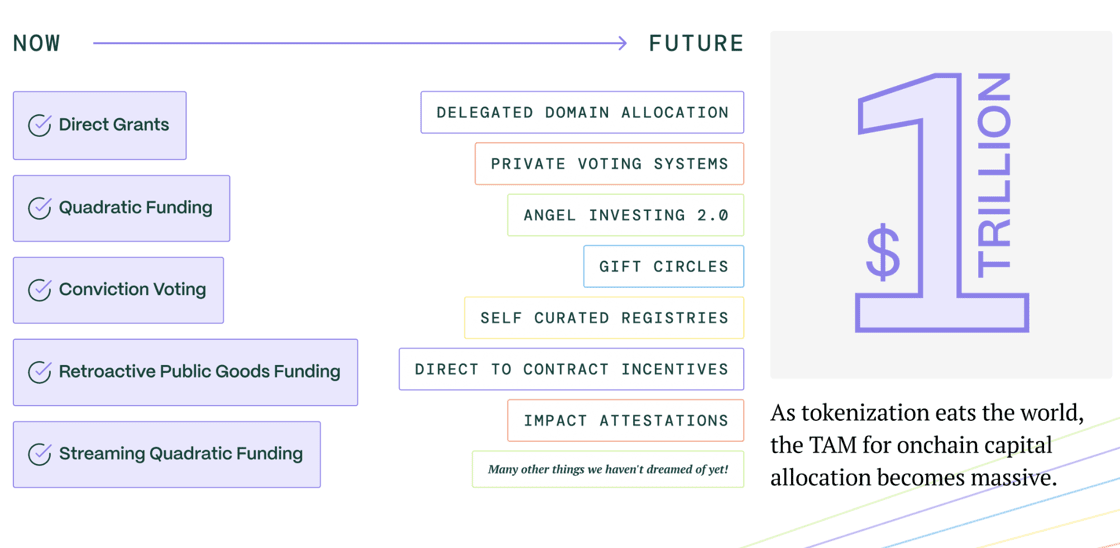Git Coin
GitCoin does it again. With their recent white paper written by Meg Lister ( Linkedin: margaretlister ) and Kevin Owocki about Tokenisation if I cut it short of explanation.
Since a picture is worth a thousand words, here is the plate that triggered our curiosity and inspired us to title this info letter with this title.
Many other things we haven't dreamed yet
The GitCoin people coined the term (AFAIK) Many other things we haven't dreamed yet and they're playing a central and/or proactive role in the inception and/or execution of the groundbreaking Quadratic Funding model support of the Quadratic Funding idea.
What the Fuck is Quadratic Funding
Here is the whole concept explained simply so that you readers can learn
The term "quadratic model of voting" refers to a type of voting system used in some decentralized governance mechanisms, particularly within blockchain-based protocols and decentralized autonomous organizations (DAOs). It's called "quadratic" because the influence of a voter's stake or voting power increases quadratically rather than linearly.
In a quadratic voting system, voters are allocated a certain amount of voting power based on the number of tokens they hold or their stake in the system. However, instead of their voting power being directly proportional to their stake (as in a linear voting system), it is proportional to the square root of their stake. This means that larger stakeholders still have more influence, but their influence increases at a diminishing rate compared to smaller stakeholders.
The purpose of quadratic voting is to provide a more balanced and fair voting system that encourages broader participation and prevents dominance by a small number of large stakeholders. It aims to give smaller stakeholders a greater voice while still acknowledging the interests of larger stakeholders.
Quadratic voting has been proposed as a method to achieve more democratic decision-making in decentralized systems, particularly in situations where there are competing interests and stakeholders with varying levels of influence. By using quadratic voting, the goal is to incentivize stakeholders to carefully consider their votes and allocate their voting power strategically, resulting in more equitable outcomes.
Overall, the quadratic model of voting is an innovative approach to decentralized governance that seeks to address some of the challenges associated with traditional voting systems, particularly in the context of blockchain-based ecosystems.
Abstract
Here is the abstract of the white paper that will give you a better idea about the GitCoin initiative which BTW, has granted millions so far in the Web 3.0.
As a leading figure in the Ethereum ecosystem, Gitcoin stands out for championing public goods through its pioneering Gitcoin Grants program. Launched in 2019, the program has funneled over $59M into public goods enriching the Ethereum ecosystem. Notably, it spearheaded the groundbreaking Quadratic Funding model, making the Gitcoin Grants program the largest QF event in web3 to this day.
Gitcoin, like many tech startups, explored a number of different products and models – including a tech accelerator, launching hackathons, and a bounty platform. In 2019, we found traction with funding public goods through Quadratic Funding. We refer to this stage as “Gitcoin 1.0” – we had gained momentum, but had not yet recognized the potential and scale of grants.
Gitcoin 1.0 was used by many top leaders in the space including Ethereum founder Vitalik Buterin and major protocols like Walletconnect, Uniswap, Yearn, and 1inch exchange. Gitcoin has been an early source of funding (and validation) for many prominent ecosystem contributors: David Hoffman (Bankless), Austin Griffith (Build Guild), Anish Agnihotri (Ritual), Carl Cervone (OSObserver), and many others.
Download their paper
Here is the PDF
References
Which RSS feed we recommend you follow
RSS Feed
We immediately got our attention upon Kevin's RSS
Here it is
You can find his feed at this url
